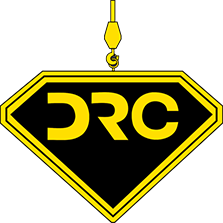The most important part of crane operations is safety. No matter what kind of job it is or what type of crane that’s being used, safety is essential. We have put together a list of the 11 best practices in crane safety to help prevent accidents. Keep in mind that this is only the beginning of job site safety with cranes. Staying safe requires attention at every step of the project.
Top Crane Safety Tips
From proper equipment maintenance to rigorous training for operators, following essential safety practices can greatly reduce risks on the job site. These safety measures protect workers, equipment, and the overall project work environment.
- Choose the Right Crane for the Job
- Hire Qualified Personnel
- Review Operator Manuals
- Conduct Daily Operator Checks
- Avoid or Clear Obstacles During Travel
- Properly Stabilize the Crane Before Rigging
- Rig the Load Correctly
- Understand Load Radius
- Adhere to Load Limits
- Use Proper Communication and Hand Signals
- Manage Complex Lifts
1. Choose the Right Crane for the Job
Safe crane operations begin with selecting the appropriate crane. Cranes are generally categorized as either mobile or fixed, with fixed cranes often used in industrial settings or on complex and tall construction projects.
Mobile cranes come in various types, so it’s essential to choose the one that best suits your specific site.
Carry deck crane
Highly mobile and easy to set up, these cranes are ideal for compact spaces but aren’t suited for rough terrain.
Crawler crane
Equipped with tracks instead of rubber wheels, crawler cranes excel on soft terrain, making them perfect for challenging job sites.
Rough-terrain crane
While these cranes are not roadworthy, they perform well on uneven ground and steep grades at the job site.
All-terrain crane
These versatile cranes can travel on public roads and navigate rough terrain, offering flexibility for various projects.
With dozens of crane types available, including some truly massive options, ensuring safety starts with selecting the right crane for the unique demands of each job site.
2. Hire Qualified Personnel
Ensuring crane safety requires that all tasks—such as setup, rigging, signaling, and operation—are performed by trained and qualified individuals. According to Occupational Safety and Health Administration (OSHA) regulations, only certified and properly evaluated personnel are permitted to operate cranes on job sites.
Adhering to these regulations is crucial to ensure that only skilled and competent individuals are operating cranes. At Diamond Rigging and Crane, we train and NCCCO certify operators to conduct safe projects.
3. Review Operator Manuals
Even with qualified personnel, it’s essential to recognize that cranes from different manufacturers have distinct controls, safety features, and specifications. Anyone involved in operating or working with cranes should thoroughly understand the specific model in use. The operator’s manual provides crucial information, including:
- Load capacities
- Safety mechanisms
- Stabilizers and counterweights
- Operator controls
Ensure that the operator’s manual is read completely before using any crane to fully grasp its unique requirements and features.
4. Conduct Daily Operator Checks
Before operating a crane, the operator must complete a daily inspection checklist to ensure the equipment is safe. These checks typically include:
- Pre-start checks: Inspect tire condition, oil levels, seat belts, air reservoir, battery, and other essential components before starting the crane.
- Engine start-up checks: Once the engine is running, verify the pressure gauge, fuel level, turn signals, horn, suspension, and other critical systems.
- Safety system checks: Perform thorough checks on safety systems to prevent accidents. This includes evaluating the anti-two block system, rated capacity limiter, and outriggers.
Operators should also carry out a series of hydraulic system checks. Refer to your site’s daily operator checklist for a comprehensive list of tasks, which usually includes over 40 items.
5. Avoid or Clear Obstacles During Travel
Before moving a crane, ensure that the travel path is thoroughly planned and cleared of obstacles. Hazards that cannot be removed, such as power lines or other permanent structures, should be carefully avoided, maintaining a safe distance. For example, regulations mandate that cranes stay at least 10 feet away from power lines carrying up to 50,000 volts.
During crane travel, a signal person should guide the crane, alerting the operator to potential hazards and warning other personnel about the crane’s movements.
6. Properly Stabilize the Crane Before Rigging
Mobile cranes use outriggers or other stabilizing mechanisms to prevent tipping during operation. When setting up the crane, consider the following:
- Adhere to the manufacturer’s guidelines for outrigger extension
- Always place outrigger pads or crane pads beneath the outriggers
- Avoid positioning outriggers over voids, depressions, or unstable ground
Improper outrigger setup is a common cause of crane accidents and tip-overs. Ensure a thorough safety assessment of outrigger placement to achieve stable and secure operation.
7. Rig the Load Correctly
Proper load rigging is essential to prevent objects from falling and potentially harming workers on site. When rigging a load, keep the following in mind:
Hitching
Choose the appropriate hitching method based on the load’s shape and weight distribution. Common configurations include basket hitching and choker hitching.
Sling Angle
Using an angle other than vertical introduces additional forces on the slings, which can reduce their weight capacity. Ensure slings are rated for both the load’s weight and the angle at which they are used.
A thorough understanding of forces, weight distribution, and rigging techniques will help ensure a safe and stable lift, even for irregular or heavy loads.
8. Understand Load Radius
To operate a crane safely, it’s crucial to grasp how the crane functions and the forces involved. One key concept is load radius, which refers to the distance between the load and the crane’s center. The farther the load is from the center, the less weight the crane can handle without risk of tipping or collapsing.
The load radius is influenced by the boom angle and the length of any telescopic extensions. When the boom is angled higher (more vertical), the load is closer to the crane’s center, allowing the boom to support more weight. When the boom is angled lower (closer to horizontal), the load is farther from the center, reducing the boom’s weight capacity.
9. Adhere to Load Limits
Even with modern cranes equipped with load moment indicators and rated capacity limiters, operators must be proficient in reading load charts to ensure a safe lift. When using load charts, consider the following:
- Rubber vs. Outriggers – Cranes can handle significantly more weight when on outriggers compared to when on tires alone. Load charts have separate columns for these conditions.
- Rotation – Cranes have higher load capacities when the boom remains over the front of the crane during the lift. If the boom needs to swing, the capacity decreases, so consult the appropriate column for accurate information.
- Load Radius -A greater load radius reduces the crane’s lifting capacity. Load charts may not cover every possible radius, so always check the next highest radius to stay within safe limits.
10. Use Proper Communication and Hand Signals
Effective crane operation relies on a standardized set of hand signals and communication protocols. A qualified signal person is essential for conveying clear instructions to the crane operator, allowing them to adjust the lift as needed.
Familiarize yourself with standard hand signals to communicate the following to the crane operator:
- The direction for the crane to travel
- When to swing and lift the boom
- When to hoist and lower the load
- When to stop the crane or secure everything
In addition to hand signals, radios are also used to maintain continuous communication during crane operations.
11. Manage Complex Lifts
Complex lifts involve handling loads that exceed 80% of the crane’s capacity, or more than 50% of the crane’s capacity for lifts on barges. These types of lifts carry a higher risk of tip-overs or equipment failure, making a detailed lift plan essential.
Develop a comprehensive plan for any complex lift, adhere to it closely, and be prepared to make adjustments as needed during the lift.
Consider renting an operated crane to ensure qualified personnel are available, which can be a cost-effective way to enhance site safety and manage complex lifts effectively.
Make Safety a Priority
Safety is the cornerstone of every crane operation and takes diligence at each phase of your project. These 11 crane safety tips provide a foundation for the safety of your construction site. We recommend completing a site analysis before every job to create a safety plan that considers every variable.
Our training school in Baytowne offers comprehensive training programs designed to equip you with the knowledge and skills necessary for safe and efficient crane operations. Register today!





